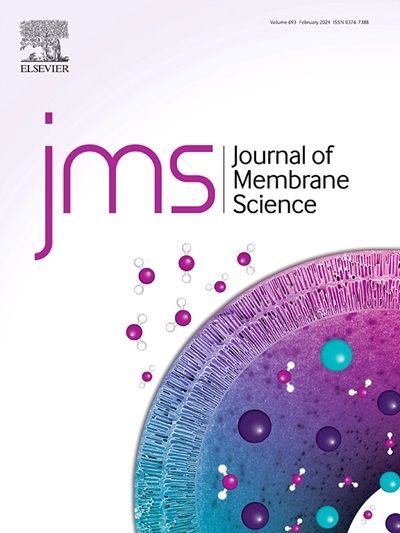Tailoring long-range ordered nanochannels in Nafion intercalated GO membrane for improved proton conduction
IF 8.4
1区 工程技术
Q1 ENGINEERING, CHEMICAL
引用次数: 0
Abstract
Proton exchange membrane (PEM) is a key component for hydrogen production from water electrolysis, and the construction of PEM with continuous and controllable proton transport nanochannels is highly desirable. Albeit two-dimensional nanocomposite membrane features continuous transmission paths, maintaining high proton conductivity and membrane structure stability remain challenges. Here, we develop a structurally stable GO/Nafion composite membrane with long-range ordered proton transport channels. The assembled GO nanosheets provide continuous and straight interlaminar nanochannels, and the inserted Nafion ionomer with sulfonate groups is capable of regulating the physical and chemical microenvironments of the interlaminar channels for boosting the proton transfer via expanding the interlaminar spacing and affecting the hydrogen-bonding network. Additionally, glutaraldehyde serves as a cross-linking agent to bond the GO nanosheets for improving the stability of the membranes. The optimal GO/Nafion composite membrane exhibits a proton conductivity of 314 mS cm−1 at 80 °C and 98% relative humidity. Meanwhile, it obtains a superior structure stability with a slightly decreased proton conductivity after immersion in water for 30 days. Moreover, the GO/Nafion membrane with GO as the main body and expensive Nafion as a modifier significantly decreases the production cost while maintaining a high proton conduction. This study which utilizes the synergistic manipulation of proton transfer channel and its microenvironments provides an effective strategy for fabricating high-performance and low-cost proton exchange membranes.

质子交换膜(PEM)是电解水制氢的关键部件,而构建具有连续、可控质子传输纳米通道的质子交换膜是非常理想的。尽管二维纳米复合膜具有连续传输路径的特点,但保持高质子传导性和膜结构稳定性仍然是一项挑战。在这里,我们开发了一种结构稳定的具有长程有序质子传输通道的 GO/Nafion 复合膜。组装后的 GO 纳米片提供了连续、笔直的层间纳米通道,而插入的带有磺酸基团的 Nafion 离子膜能够调节层间通道的物理和化学微环境,通过扩大层间间距和影响氢键网络来促进质子传输。此外,戊二醛可作为交联剂粘合 GO 纳米片,从而提高膜的稳定性。最佳的 GO/Nafion 复合膜在 80 °C 和 98% 相对湿度条件下的质子电导率为 314 mS cm-1。同时,它还具有优异的结构稳定性,在水中浸泡 30 天后质子传导率略有下降。此外,以 GO 为主体、昂贵的 Nafion 为改性剂的 GO/Nafion 膜在保持高质子传导性的同时,还大大降低了生产成本。这项研究利用质子传输通道及其微环境的协同操作,为制造高性能、低成本的质子交换膜提供了一种有效的策略。
本文章由计算机程序翻译,如有差异,请以英文原文为准。
求助全文
约1分钟内获得全文
求助全文
来源期刊

Journal of Membrane Science
工程技术-高分子科学
CiteScore
17.10
自引率
17.90%
发文量
1031
审稿时长
2.5 months
期刊介绍:
The Journal of Membrane Science is a publication that focuses on membrane systems and is aimed at academic and industrial chemists, chemical engineers, materials scientists, and membranologists. It publishes original research and reviews on various aspects of membrane transport, membrane formation/structure, fouling, module/process design, and processes/applications. The journal primarily focuses on the structure, function, and performance of non-biological membranes but also includes papers that relate to biological membranes. The Journal of Membrane Science publishes Full Text Papers, State-of-the-Art Reviews, Letters to the Editor, and Perspectives.
 求助内容:
求助内容: 应助结果提醒方式:
应助结果提醒方式:


